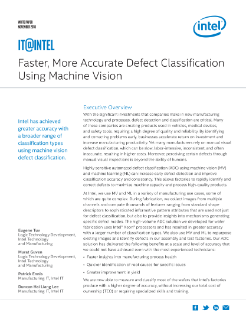Defect Classification Using Machine Vision
With the significant investments that companies make in new manufacturing technology and processes, defect detection and classification are critical. Many of these companies are creating products used in vehicles, medical devices, and safety tools, requiring a high degree of quality and reliability. By identifying and correcting problems early, businesses accelerate return on investment and increase manufacturing productivity. Yet many manufacturers rely on manual visual defect classification, which can be slow, labor-intensive, inconsistent, and often inaccurate, resulting in higher costs. Moreover, perceiving certain defects through manual visual inspections is beyond the ability of humans. Highly sensitive automated defect classification (ADC) using machine vision (MV) and machine learning (ML) can increase early defect detection and improve classification accuracy and consistency. This allows factories to rapidly identify and correct defects to maximize machine capacity and process high-quality products. At Intel, we use MV and ML in a variety of manufacturing use cases, some of which are quite complex. During fabrication, we collect images from multiple channels and compute thousands of features ranging from standard shape descriptors to sophisticated informative pattern attributes that are used not just for defect classification, but also to provide insights into mechanisms generating specific defect modes. The high-volume ADC solution we developed for wafer fabrication uses Intel® Xeon® processors and has resulted in greater accuracy with a larger number of classification types. We also use MV and ML to repurpose existing images and identify defects in our assembly and test factories. Our ADC solution has delivered the following benefits at a scale and level of accuracy that we could not have achieved even with the most experienced technicians: faster insights into manufacturing process health, quicker identification of root causes for specific issues, and greater improvement in yield. We are now able to measure and classify most of the wafers that Intel’s factories produce with a higher degree of accuracy, without increasing our total cost of ownership (TCO) or requiring specialized skills and training.
